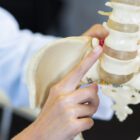1. Avoid the bed
Of course, everyone enjoys working on a laptop in the comfort of the bed but after a while, their neck and back start paining. After, a little bit of adjustment you again go back to work. But this cycle keeps repeating and at the end of the day it feels very tiring and neck and back muscles start paining a lot. Now, even if you want to use the chair and table, your neck and back muscles give up as they become weak. So, the best thing to do is to avoid working from bed.2. Makeshift Ergonomic Workspace
If you have a desktop at home with a docking station, well & good! however, most of us nowadays at home use a laptop. The laptop is a very good choice if you want to use it for a short period but using it for a longer period can result in chronic neck &back pain, carpal tunnel syndrome, etc. Now when you are working from home due to Corona Virus for longer periods, the best thing to do is to get an ergonomic keyboard and mouse with wrist support. A commercial riser is very important so that your eyes level with the top of the screen and neck pain can be avoided. The arms should be angled slightly downwards when you are typing, the best solution is to buy a keyboard tray so that the keyboard is kept under the tabletop or an adjustable chair. Whatever you want to use frequently like your cell phone, notebook, headphones, etc should be kept well within the limits of your arm length. An adjustable chair is very important so that you don’t have any knee pain at the end of the day as your feet touch the floor and eyes level with the top of the screen. The armrest should be such that you can type while your arms are slightly downwards. Also, please use back support on the chair if you already have a weak back. People with knee problems can use a footrest. The best way to check if your makeshift workspace is perfect, extend one arm horizontally and you will notice you touch your center of the laptop screen while its place on the riser. While sitting thighs will be horizontal and knees are at right angles when seated.3. Take care of your eyes
An average person blinks 18 times in a minute which releases a teardrop and lubricates the eyes. But while looking at a screen for a long period you do less than 9 times resulting in dry irritated eyes & eye fatigue. The simplest solution that is prescribed in ophthalmology is ‘20-20-20’. After every 20 minutes, look at something 20 feet away and blink 20 times. And, please take a break after a marathon session with your laptop, after all, you are in your home.4. Take a Break
Give Yourself Movement Breaks. One of the crucial reasons why desk work is tied to back pain and chronic disease is because it limits the amount of movement required for better health To reduce the health risks of sedentary work, it’s important to make time for scheduled breaks and perform good posture exercises throughout the day. Stretching overhead and opening up your chest and back can counteract slouching. A brisk walk around the room can help boost circulation and energy.5.Practice Neutral Posture
Despite an efficient workspace, you still risk of pain in the back and neck if you do not take care of your posture. Neutral posture means that the key joints especially the spine of a person’s body are correctly aligned and supported by the right amount of muscle tension.6. Enjoy Exercise
It takes a little effort to go to your office and come back. This is the effect that gives you a little exercise that your body needs. But with Corona Virus lockdown and you just sitting and working from home even that exercise is cut down from your lifestyle which can lead to chronic musculoskeletal ailments. A little exercise is always good. The following exercises should be done at least every 6 hours to avoid pain in the body and feeling refreshed- Stretches: You should stretch your neck bending it forwards and backward 3 times slowly. For back raise your hands then go back as much as you can and then touch your knee. After that do cobra pose for your lower back.
- Turning: Keep your knee width shoulder apart and turn your neck sideways for 3 times. Rotate your right ankle so that your left ankle is forward-facing and your right ankle is facing right. Raise your hands at the level of your shoulder with palms facing the floor. Turn your head towards your left hand and tour right toe. Similarly, touch your left toe.
- Strengthening: are needed to help your core muscles develop the capacity to withstand excess pressure if needed. Many people think that stretches are enough but if not clubbed with strengthening exercises, people may develop back & neck ache. There are just five basic strengthening exercises that can get you through challenging times which are wall push-ups, pull-ups (using Therabands are recommended), lifting something heavy every day and squats.
7. Prevention is always better than cure.
Yes, defeating Corona Virus and sedentary lifestyle diseases have the same strategy, ‘Prevention is better than cure. Overuse of the muscles through repeated movements can put stress on your body, causing a Repetitive Strain Injury (RSI). Unfortunately, work from home job requires that we perform repetitive motions to fulfill our duties like constant typing, clicking on the mouse, etc. For this reason, RSIs are the most common type of injury found in the ‘work from home offices’. According to studies, any symptoms of musculoskeletal disorder shows only after your body has adjusted itself till 90% of its adaptive capability meaning that if you have back pain, then initially your body will help the back with the supporting muscles and you will not know pain until the core muscles become 90% weak to feel pain. Detection becomes very important to prevent any kind of irreversible chronic disorder. Based on the intensity of pain you will be able to detect the injury:- Early: At this stage, the body aches but after work aches and fatigue disappears. These injuries can be easily healed if given proper attention. At Orthocure have we have MedX therapy & Doctor of Chiropractic who can help by strengthening the core muscles and doing structural correction respectively.
- Intermediate: At this stage, the pain area aches even after work and we can deal this using medicines, advanced physiotherapy and chiropractic adjustments for pain relief and strengthening of supporting muscles.
- Advanced: The pain area will ache and feel weak, even at rest or when you are asleep. Even light duties like standing for 10 minutes will be difficult. Yes, it is still possible to recover but for the body to come to this stage takes around 3- 6 months and the same amount of time is required to healing the body, strengthening and structurally correct it.
Disclaimer
This information should not be used as a substitute for professional diagnosis and treatment as this is for informational purposes only. One must consult their healthcare provider before making any healthcare decisions. Any damage, loss or injury suffered by an individual as a result of reliance on the information contained on this site is neither the responsibility nor the liability of Orthocure Clinics.




